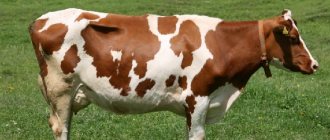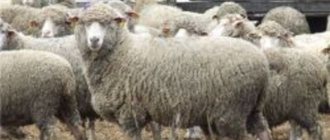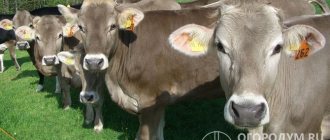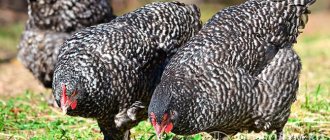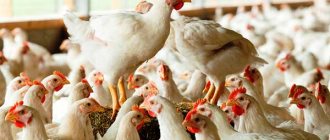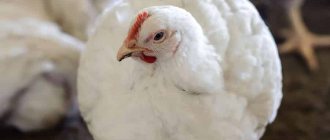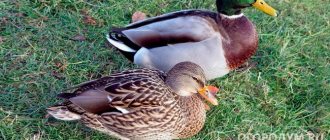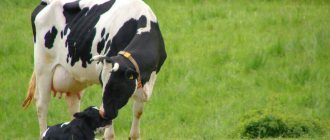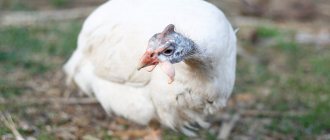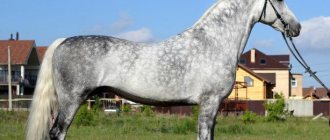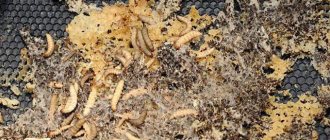Grade Maker is a meat cross of turkeys bred by Canadian breeders. Representatives of this species quickly gain weight, their meat has a high taste, and is often used for preparing holiday dishes. The cross is most suitable for breeding in small private farms, for which it was originally developed. In this material we will look at what kind of breed this is, what the appearance and character of such turkeys are, what their productivity is, how best to keep grade maker birds depending on their age, and also how to protect them from diseases.
Turkey Hybr >
Hybrid turkey Hybrid Grade Maker was bred by professional veterinarians in Canada. It is not very common in our country, as it is heat-loving. But, despite this, poultry meat of this breed is sold in many stores in Russia. The cross is a medium-heavy breed and is popular due to its fast growth and good immune system. It is less demanding in maintenance and resistant to disease. And the main criterion by which experienced farmers choose the Hybrid Grade Maker cross is high meat precocity. By 10-12 weeks the turkey is ready to cover all expenses, has a good presentation, weighs about 5 kilograms. It is at this moment that poultry slaughter is most profitable. The carcass, by this time, has the most presentable appearance in its uncut form.
Main characteristics of the Hybrid Grade Maker cross.
The turkey of this breed has white, fluffy plumage and a wide, powerful chest. Males gain about 18-20 kilograms of mass by 140 days of life. Females weigh approximately 10 kilograms at 126 days. Despite their disease resistance, birds are sensitive to cold and dampness. Turkeys are very confrontational birds and often fight among themselves.
If you maintain this hybrid correctly, it will bring considerable profit. To do this, you need to take into account all the features of the Hybrid Grade Maker breed and know the rules for creating the most favorable conditions for the turkey. Without this, it is impossible to guarantee the quality of the bird and its 100% health.
Breeding Hybrid Grade Maker is possible only in warm and dry climates. In a large, airy room without windows, there may be a mat or a metal cage on the floor. Lighting should be adjustable. In the poultry house, on the south side, it is necessary to install a ladder for them to independently exit the room, 10-15 centimeters high. It is important that there is a spacious courtyard near the cages, because these birds really love freedom and space.
Professionals advise clipping the cross's wings or installing a high pen, as this poultry has not lost its abilities and easily flies through a low cage. Considering their difficult temperament, 30-35 Hybrid Grade Maker females should be kept in one room along with 3-4 males. A female over 5 years old and a male over 4 years old cannot get along in a common herd.
To remove eggs, a wooden perch is installed in the poultry house at a height of 90-100 cm. The width of the bars is 73 cm, located at a distance of 40 centimeters from each other. Ideal nests for laying hens should be 60 cm wide, 60 cm deep and 15 cm high. Up to 5 hens can be accommodated in one nest.
To keep birds' plumage free of parasites, you need to give them baths in ash. To do this, a wooden box measuring 125x80x25 cm is filled with ash and fine sand in a 1:1 ratio and the contents are replenished from time to time.
Meat Hybrid Grade Maker.
Turkey meat is famous for its beneficial qualities; it is very tender meat with minimal fat content. Turkey meat is beautiful in any version, it can be prepared in different ways. The breast is stuffed with vegetables, mushrooms, nuts and so on.
Frequent diseases of birds
Birds of this breed are characterized by good immunity. However, birds cannot tolerate exposure to drafts. Turkeys are resistant to most infections. It is important to get vaccinated against the following pathologies:
- chicken coccidiosis;
- rhinotracheitis;
- atypical plague.
Vaccination should be carried out exclusively by a veterinarian, and vaccinations are recommended only for healthy birds. If there are symptoms of pathologies, it is better to refuse the procedure. After vaccination, birds need to be isolated for some time. Grade maker turkeys are considered popular birds that are highly productive. In order for birds to grow and develop quickly, they need comprehensive care.
Productive indicators
Grade maker - medium-heavy cross. Its growth rate is quite fast.
Productivity characteristics look like this:
- the live weight of males reaches 18–20 kg by 4.5 months, females weigh half as much (at 4 months their live weight is approximately 9–11 kg, however, these weight indicators are enough to recoup the cost of rearing);
- the optimal slaughter age for poultry is 4–4.5 months, sometimes farmers slaughter poultry at 10–12 weeks (by this time its weight reaches 4–5 kg, and the meat of young birds is even more tender and juicy);
- oviposition begins at the age of 8–9 months;
- turkeys lay from 80 to 100 eggs during the reproductive period, egg hatchability is 87%;
- the weight of one egg is 80–85 g, their color is gray or beige of varying intensities with brown splashes over the entire surface.
Turkey Grade Maker: description + description
Turkey Grade Maker is a medium-sized cross of white broad-breasted turkey bred in Canada. Excellent for growing at home. In Europe this turkey is called "holiday".
Not many farmers are breeding this cross in Russia yet, however, Grad Maker is gradually beginning to gain popularity.
This is not surprising, because these turkeys have a lot of positive qualities.
Advantages of the Grade Maker cross
- turkeys have rapid maturity: at 10-12 weeks they weigh at least 4 kg;
- Grade Maker turkeys have high endurance, their development is very active;
- Birds have good resistance to stress;
- Turkeys of this cross have a good immune system, therefore, high resistance to disease;
- when breeding Grade Maker turkeys, the costs quickly pay off;
- The carcasses of this cross have a beautiful presentation.
Features of the Grade Maker cross
Turkeys have large breasts and fluffy plumage. Males reach a weight of 18-20 kg by 4.5 months, females gain weight of 10 kg in 126 days.
The photo shows the parameters of the Grade Maker turkey
Females produce from 80 to 100 eggs during the reproductive period (on average, 12 eggs weighing 85 g per month). Egg hatchability is 87%
Conditions for keeping the Grade Maker cross
Since Grade Maker turkeys are heat-loving, they need to be provided with a dry and warm room in which they will be. It is necessary that there is sufficient lighting, but there should be no windows in the room.
Turkeys should have a place where they can clean themselves: a box with a mixture of ash and sand - this avoids the appearance of parasites.
Turkeys sleep on roosts. Given the large weight of the birds, the timber must be of appropriate thickness. Each bird should have at least 40 cm of space. The height of the perch should be 80 cm, the width between places should be at least 60 cm.
How this looks in practice - watch the video.
Turkeys have a rather quarrelsome nature; during fights they can seriously injure each other. Therefore, no more than 5 males and 40 females should be kept in one place.
For good egg production of females, it is necessary to properly equip her place. The height of the nest should be on average 15 cm, width and height - 60 cm. These sizes are suitable for 4-6 females. Hens are very caring: they can provide care for a large number of chicks - up to 80 pcs.
Organizing feeding of Grade Maker cross turkeys
Birds need to be fed at least 3 times a day, during the reproductive period - up to 5. Type of food - combined, consisting of wet and dry mash.
The diet must include grain feed: sprouted and dry. It is best to give wet mash in the morning and afternoon, and dry grain in the evening feeding. During the season, turkeys should be fed plenty of greens.
In winter, you need to introduce vitamin supplements: beets, carrots, cabbage.
Advice! In spring and summer, you can dry the grass and add it, after steaming it, to feed turkeys in the autumn-winter period.
At this time, the chicks need to be fed 8 times a day. First they give a mixture of their boiled eggs and small cereals. From 1 month, finely chopped greens (alfalfa, nettle or cabbage) are added to the mixture.
There are special feeds for young animals on sale. At first, turkey poults have soft beaks that can easily be injured on the surface of the feeder.
To avoid injury, you need to use silicone, rubber or fabric feeders.
Advice! When organizing feeding for young animals, it is advisable to use grooved feeders.
https://www.youtube.com/watch?v=s0dNwpOZr74
When choosing a drinking bowl, you should give preference to one that is safe for the chicks: so that the turkey chick cannot fall into it, get wet and get cold.
For newborns, the water temperature should be 25 degrees Celsius; for older turkey poults, it should correspond to the air temperature in the room. The drinking bowl and feeder should be in a place where they will be clearly visible to the kids, because...
At first, the chicks have poor vision. For the same reason, bright foods are added to the food: colored cereals, yolk.
Sunlight and fresh air are very important for the health of children. If turkey poults grow up under the supervision of a female, they can be released for walks from the age of two weeks, if alone - when they reach 9 weeks.
Conclusion
Turkeys of the Grade Maker cross are ideal for beginning breeders: with good early maturity and egg production, the birds are quite unpretentious in care and feeding. The costs invested in turkeys pay off fairly quickly, and the meat and eggs are tasty, healthy and easily digestible.
Conditions of detention
To successfully breed this cross, it is necessary to comply with the conditions for comfortable development of the bird.
How to equip a poultry house
Turkeys should sleep on perches . Since representatives of the species in question are heavy birds, you need to take care of their strength. The beam must have sufficient thickness. The height of the perches should be 80 cm, and the width between them should be at least 60 cm.
For a group of three birds, 4–5 square meters should be allocated. m of turkey poultry area.
For better egg production, the female needs to properly equip her place for laying . In a secluded corner, install a nest from a basket or wooden box. Place straw or hay in it. The average height of the nest should be 15 cm, width and height - 60 cm. A nest of this size is suitable for 4-6 hens.
Always maintain the optimal temperature for these birds: for adult birds it is +22–23 °C.
In addition, the turkey house should not be damp or dirty. These two factors provide a favorable environment for pathogenic bacteria. Housing for turkeys should be dry, without a leaky roof or wet bedding.
To prevent heat from escaping, you need to ensure that there are no drafts in the poultry house. However, opening windows or vents is necessary to bring in fresh air.
There are no special requirements for raising young animals. The main thing is to guarantee constant temperature readings in the first two weeks (not lower than +35 ° C). It is also necessary to ensure that the turkey poults receive sufficient sunlight. It promotes rapid growth and the formation of a good immune system in birds.
Its deficiency on cool spring days can be compensated for by conventional incandescent lamps. For birds older than 7–10 days, heating will no longer be needed. However, there should always be enough light in the turkey poultry house. To do this, you can make several small holes in its walls to allow sunlight to penetrate.
Walking yard
Since turkeys of this breed quickly gain weight, they should have a place for daily walks. An active lifestyle will prevent obesity and help maintain good immunity. For this purpose, a spacious pen is created , which can be accessed directly from the poultry house. It is advisable to fence the yard with a high fence, since turkeys of this species can fly quite high. Or you can clip the wings of young individuals, which we will discuss below.
Walks should last at least an hour a day. Cubs can be released for walks from the age of 14 days, but only when accompanied by a female. Turkey poults can be released into the yard unaccompanied from the age of 2 months.
Feeders, drinkers, sand container
It is necessary to prepare for the purchase of chicks in advance by purchasing equipment (drinkers, feeders) and installing containers with sand. For young animals, these items should be made exclusively of soft material (silicone or rubber) so that the young ones do not injure their soft beaks. Always install drinking bowls next to incandescent lamps, this will keep the water temperature at a stable level (not less than +24 °C). This rule applies to chicks under the age of 1 month.
The height of the feeder for adult representatives of grade maker should be on average 15 cm. Any suitable vessel will be suitable as a drinking bowl. The main requirement is to install the container on a hill so that all kinds of debris do not get into the water.
Nesting
The dimensions of a good nest for Grade Maker hens should meet the following parameters: height 14–16 cm, width 55–65 cm, depth 60 cm. Such “apartments” can accommodate from 4 to 6 turkeys, providing them with an excellent place to lay eggs.
The proven method of taking “dry baths”, the contents of which are ash and sand in equal quantities, will help you avoid all kinds of parasites. This mixture should be placed in a small box, the ideal dimensions of which are 130x85x30 centimeters. As you use it, you should not forget to replenish the supplies in the box, which will serve as a good guarantee of the health of Hybrid Grade Maker turkeys.
Have you ever experienced unbearable joint pain? And you know firsthand what it is:
- inability to move easily and comfortably;
- discomfort when going up and down stairs;
- unpleasant crunching, clicking not of your own accord;
- pain during or after exercise;
- inflammation in the joints and swelling;
- causeless and sometimes unbearable aching pain in the joints.
Now answer the question: are you satisfied with this? Can such pain be tolerated? How much money have you already wasted on ineffective treatment? That's right - it's time to end this! Do you agree? That is why we decided to publish an exclusive interview with Professor Dikul, in which he revealed the secrets of getting rid of joint pain, arthritis and arthrosis.
Read the interview.
Wing trimming
If you plan to keep some of the turkeys for the future, at the age of 3-4 months it is necessary to trim the flight feathers on the wings. The procedure will prevent the bird from flying through the mesh and will not give it the opportunity to escape.
It is advisable to trim only one wing - the bird will lose the balance required for flight. Pruning is carried out by two people - one holds the turkey, the other uses scissors or pruning shears.
After molting, the feathers grow back and will need to be trimmed again. For birds from 6 months of age, feathers are not trimmed, but tied on the back.
Hybrid
The leader in genetic changes in turkey breeds is. From a small farm with just 500 birds, she has grown to become the largest producer in the turkey industry. Today the company offers its leading developments: Hybrid Converter, Hybrid XL and Grade Maker.
Heavy breed of turkey, popular all over the world
“Hybrid Converter” is suitable for poultry farmers for whom it is most important to obtain a turkey with a high meat mass and quickly increase the profitability of their poultry farm. The breed excels in converting feed into body weight and is sensitive to modern market demands.
Birds of the Hybrid Converter breed have proven themselves to be hardy, able to survive in any climatic conditions, and not demanding in terms of maintenance. Therefore, many farmers focused on large and quick sales choose them to raise turkeys without the use of antibiotics.
Hardy meat breed
“Hybrid XL” is the bird with the largest body weight among those presented. Its enormous weight is emphasized by the “XL” marking. Turkeys of this breed reach a weight of up to 25 kg by the 22nd week of life - they are the largest representatives among turkeys of hybrid breeds, characterized by a small head, an impressively wide sternum and very fluffy white plumage. An additional advantage is the excellent feed conversion rate and high viability of the birds.
Medium-heavy breed for the whole carcass market
The Grade Maker hybrid was created to meet consumer demand for whole medium-sized birds and more convenient oven baking. However, the yield of white breast meat remains quite large, and other parts of the carcass are also of high quality. Grade Maker turkeys gain up to 20 kg of weight by the fourth month of life. Hybrid Grade Maker birds are not difficult to raise and do not have some of the problems of large crosses. Thus, they have strong leg joints, no digestive problems and high feed conversion, but they should not be kept at a constant temperature below 18-20 degrees.
To increase profits and reduce losses when growing heavy breeds, you need to know their features:
- Feed only special food with mineral and vitamin supplements.
- The diet of a young hybrid turkey should include plenty of protein foods.
- It is necessary to do mandatory vaccinations, give nutritional supplements and medications on the recommendation of a veterinarian or breeder, because these birds are generally vulnerable to infectious and gastrointestinal diseases.
- The profitable growing period to slaughter is 3 to 4 months. Longer feeding times reduce profitability.
- Males show much higher fattening weights than females.
- Considering the difficulties of growing and the significant difference in the weight of turkeys and female turkeys, young animals should be purchased exclusively from reliable breeders, otherwise expectations from the breed may not be met.
Feeding ration
Let's look at how to properly organize feeding of adult and young representatives of the Grade Maker cross.
What to feed adults
Adults of the breed in question love to eat. They need to be fed at least three times a day. During the mating season, the number of meals increases to 4–5 daily. The basis of the menu is dry and sprouted grains. In the warm season, fresh greens must certainly be present in the diet.
Give the turkeys wet mash in the morning and for lunch, and offer dry grain for dinner.
What to feed turkey poults
During the first month of life, chicks should eat 7–8 times a day. Give your kids a mixture of crushed boiled chicken eggs and raw wheat cereal. From the seventh day you can include cake, fish meal, and cottage cheese in your diet. From the twentieth day of life, in addition to wheat, you can give turkey poults other dry grains (corn, millet). After 4 weeks, while continuing to feed similar mixtures, gradually introduce fresh herbs (clover, alfalfa or cabbage leaves) into the diet. The greens must first be finely chopped. You can also give special combined feeds for chicks.
Vitamin supplements
In winter, birds need additional organic (vitamin) supplements. Introduce natural vitamin supplements consisting of beets, carrots and cabbage. You can dry the tops of these plants in advance, even in the summer, and already in the winter offer these additives to turkeys in steamed form.
Hybrid grade mayker
Turkeys of the Hybrid grade maker breed (read “hybrid grade maker”) were obtained during long-term experiments on crossing selected breeds. Initially, the goal was to obtain breeds with high live weight and excellent taste characteristics.
Turkeys Grade Maker on a private backyard
Description of the breed and its advantages
It is a hybrid (cross) medium-heavy species. Among European, American and Canadian farmers, it is commonly called “holiday”, since these are the birds that most often end up on the table during Thanksgiving and other celebrations. This is a medium-heavy cross with good meat.
The cross was bred in Canada. The color of the plumage is snow-white, the cover is fluffy. Turkeys are characterized by a wide, powerful chest. The growth rate is quite high - so, by 4 months, individuals reach:
The breed has long been grown on Western farmsteads. In Russia, these turkeys are not yet very widespread, but they have every chance of becoming so, since they have several important advantages:
- turkeys gain weight quickly;
- due to such growth rates, investments pay off quickly;
- the meat has good taste and is optimal for dietary nutrition, since the fat content is minimal;
- they are quite resilient to environmental conditions due to their strong immune system, and their breeding in Russia has real prospects;
- carcasses have an attractive presentation.
Breeding the hybrid grade maker breed can be carried out even in the Siberian climate, if you take into account several important points, which are described below.
Breeding can be carried out even in the Siberian climate
Conditions of detention
The basic requirements that must be taken into account when breeding turkeys of this breed are the following:
- Maintaining a constant high temperature - birds really do not like the cold, so they will not tolerate it if the temperature in the poultry house drops below 18-20 o C. The optimal value for adults is room temperature (22-23 o C).
The temperature in the poultry house should be comfortable for the birds
It is important to ensure that there is no dampness in the poultry house.
There should be 7-8 turkeys per 1 male
Minimum perch height – 50 cm
Turkeys love sunlight very much.
A container of sand helps turkeys get rid of skin parasites
Note! Only those turkeys that have a healthy, normal appearance can be vaccinated. At the same time, you should not give water to drink for the first hours after vaccination.
Since birds gain weight well, they need to be provided with conditions for daily walks to prevent possible obesity. For this purpose, a special pen is created, which can be accessed directly from the turkey poultry.
By taking daily walks, birds will be able to maintain good immunity.
Prices for fencing for birds made of chain-link mesh
Representatives of the hybrid grade maker love to eat, so the minimum number of feedings is three times a day. During the mating period, the number of doses increases to 4-5 daily. The basis of the diet is dry and sprouted grains. During the warm season, fresh herbs are a must. And in winter, you can provide additional vitamin supplements of natural origin - beets, cabbage and carrots. You can dry the tops of these and other cultivated plants in advance in the summer, and then give them steamed in winter.
Minimum number of feedings – three times a day
Note! It is better to give birds wet mixtures in the morning and lunchtime, and dry grain for dinner, since during active hours the digestion of wet mixtures is best.
As for pruning, it is done upon reaching 16-17 weeks of age.
Turkey wing trimming diagram
In general, the Grade Maker is kept in the same conditions as other breeds. The fundamental difference is that birds are particularly demanding of a dry, warm microclimate.
Video - Wing clipping
Pros and cons of cross
Turkeys grade maker are noted for many advantages :
- rapid development and increased rate of weight gain (without the use of intensive growing techniques);
- excellent taste, healthfulness and ease of digestibility of meat and eggs;
- beautiful presentation of carcasses;
- good immune system and high resistance to disease;
- undemanding feeding;
- excellent stress resistance;
- When raising poultry, the costs pay off quite quickly.
The only negative that can be highlighted is that the cross is very sensitive to temperature changes and grows comfortably only in warm conditions.
Breed characteristics
Grade Maker is a medium-heavy breed of turkey. Representatives of this cross gain weight well, are less prone to illness, and have average productivity. They grow well in various climatic conditions; if the temperature in the poultry house is maintained at a stable temperature, they can be bred even in Siberia. The birds are unpretentious to food and inexpensive to breed; the cost of their maintenance pays off in the first year.
A significant disadvantage of turkeys is their quarrelsome nature: males often fight for the attention of females and can cause serious injuries to each other. For this reason, the proportions of females and males in the house should be strictly observed.
Appearance
This cross has a massive body covered with fluffy snow-white plumage. The chest of representatives of this species is wide and smooth. The beak is yellowish, long, curved. Males have red stripes on it. The head is small, pinkish or reddish in color. The earrings are long red. In some individuals, the face near the eyes has a blue color.
The main reason for culling individuals of this species is the discrepancy between the thickness or shade of feathers and the specific characteristics. Birds with darker plumage are not used for further breeding on the farm and are usually immediately sent to slaughter.
Character
Representatives of the grade maker cross have a quarrelsome character. Males of this breed regularly fight among themselves. This way they attract the attention of females. During a fight, they can cause damage even to their owner, so they must be handled with extreme caution.
You should also take into account the sex ratio in the poultry house: there should be at least 7 females per male.
It should be remembered that during fights such birds can cause serious injuries to each other. For this reason, it is important to keep order in the house and separate the males from each other.
Advantages and disadvantages
The grade maker breed has many advantages. Among them it is necessary to note the following:
- high rate of weight gain;
- attractive appearance of the carcass;
- low costs of maintaining individuals;
- birds' unpretentiousness to food;
- increased resistance of individuals to diseases and stress.
The main advantage of the presented breed is the excellent taste characteristics of not only meat, but also eggs. Because of them, the cross is in high demand both among large buyers and small clients cooperating with poultry farms.
The only drawback of this type of poultry is its sensitivity to temperature changes. Because of this factor, turkeys may begin to get sick, lose weight, and reduce egg production. They should be kept only in comfortable temperature conditions.
Origin
Grade Maker is a hybrid obtained by the Canadian company Hendrix Genetics. To obtain it, breeders successively crossed wild birds with domestic turkey species. Thanks to this selection, it was possible to obtain a hybrid of a white broad-breasted turkey, which gains weight well and is resistant to various diseases. It was developed specifically for use in small private farms. Find out which turkey breed is the largest by following this link.
Due to its large mass yield, this bird is often used in the USA, Canada, and Europe for preparing holiday dishes. Due to this, this cross began to be called the “holiday turkey.”
Productivity
The presented breed is used primarily for meat production. This is facilitated by the rapid rate of weight gain in both females and males, the good quality of the meat obtained, and the large weight of the cut carcass. Individuals of this species can be sent for slaughter at an early age - on average, this is done at the 4th month of a bird’s life, less often at the age of 12 weeks. During this period, poultry meat is most tender, and the individual itself usually reaches a weight of 4.5 kilograms, which is quite acceptable for sale. Read how to carve a turkey here.
Meat output and weight gain
By 4 months, the weight of a turkey reaches 20 kilograms. The female weighs almost half as much - she grows up to 11 kilograms. By the middle of the third month of life, turkeys reach the minimum weight that is profitable for poultry slaughter - 4.5 kilograms. Weight gain occurs easily and quickly and requires the breeder to only follow basic recommendations for feeding individuals without the use of specialized feed mixtures. The benefit of turkey meat is that it is dietary: 58% of body weight is meat and only 8% is fat.
Description
Turkey Vulture Skull
| Sounds of a turkey poultry |
| Problems playing this file? See Media Help. |
This large bird has a wingspan of 160–183 cm (63–72 in), a length of 62–81 cm (24–32 in), and a weight of 0.8 to 2.41 kg (1.8 to 5.3 lb) . Birds at the northern limit of the species' range are on average larger in size than the Neotropical vulture. The 124 birds from Florida weighed on average 2 kg (4.4 lb), while the 65 and 130 birds from Venezuela weighed on average 1.22 and 1.45 kg (2.7 and 3.2 lb), respectively. It exhibits minimal sexual dimorphism; The sexes are identical in plumage and color, and similar in size. The body feathers are mostly brown-black, but the flight feathers on the wings below appear silvery-gray, contrasting with the darker wing pads. The adult's head is small in relation to the body, red in color, with few or no feathers. It also has a relatively short, ivory, hooked beak. The iris of the eyes is gray-brown; the legs and feet are pink, although usually colored white. The eye has one partial row of eyelashes on the upper eyelid and two rows on the lower eyelid.
Turkey vulture ( C. a. septentrionalis
) in flight (Canada)
The two front toes are long, with small webs at the base. The marks are large, 9.5 to 14 cm (3.7 and 5.5 in) long and 8.2 to 10.2 cm (3.2 and 4.0 in) wide, both measurements including claw marks . The toes are arranged in a classic pattern. The feet are flat, relatively weak and poorly adapted for grasping; The claws are also not designed for grasping as they are relatively blunt. In flight the tail is long and thin. The black vulture has a relatively short tail and shorter wings, which makes it appear quite smaller in flight than the turkey vulture, although the body masses of the two species are approximately the same. The nostrils are not separated by a septum, but rather are perforated; visible from the side through the beak. Molting occurs at the end of winter - beginning of spring. This is a gradual molt that continues until early autumn. The immature bird has a gray head with a black beak tip; the coloring changes to adult coloration as the bird matures. Life expectancy in captivity is little known. As of 2022, there are two birds over 45 years of age in captivity: the Gabbert Raptor Center on the University of Minnesota campus has a turkey vulture named Nero with a confirmed hatching year of 1974, and another male bird named Lord Richard lives at Lindsay Wildlife Experience in Walnut Creek, CA. Lord Richard hatched in 1974 and arrived at the museum later that year. The oldest striped bird caught was 16 years old.
Leucistic (sometimes incorrectly called "albino") turkey vultures are occasionally found.
The turkey vulture, like most other vultures, has very little vocalization ability. Because it does not have a syrinx, it can only hiss and grunt. It usually hisses when it feels threatened or is fighting with other vultures over a carcass. Grunting is commonly heard from hungry juveniles and adults during courtship.
What documents are needed to open a farm?
The list of mandatory documentation for the line of business in question depends on the chosen organizational and legal form, but, as a rule, it includes:
- standard papers of LLC/IP or peasant farm;
- lease agreements (for land, buildings, etc.);
- staff contracts;
- permission from SES, fire inspection and local authorities;
- agreements with counterparties;
- product certificates;
- veterinary services papers.
Try to communicate with representatives of the SES and veterinarians as often as possible so that you always have the most recent papers confirming the high quality of your products.
